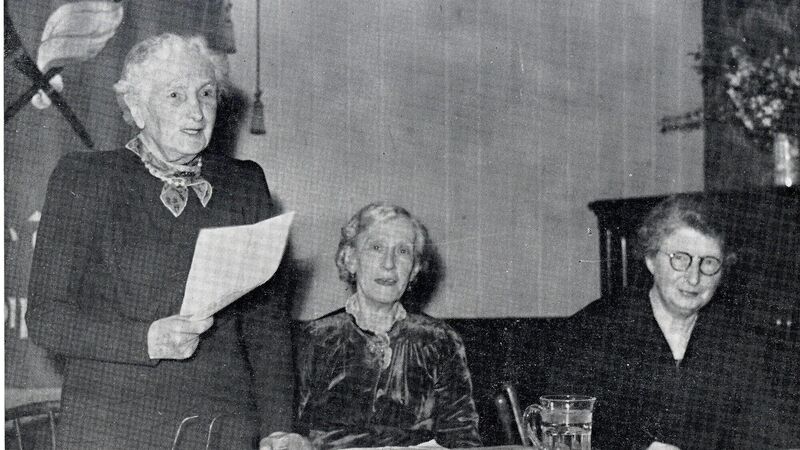Clodagh Finn: Are we about to see a new golden age for trade unions?

Earlier this year, Mick Lynch, the eloquent, popular general secretary of the union (RMT) that led one of the biggest rail strikes in the UK in recent decades, named the Irish labour leader and revolutionary James Connolly as his hero.
This week, I was reminded why trade union leader Louisa ‘Louie’ Bennett was one of mine. I’m sure she made many rousing speeches in her time, but it was something she said at the end of her life that resonated with me the most. Indeed, it will speak to anyone who suffers from impostor syndrome (which is most of us, if we’re honest, or if we have any self-awareness at all).
She confessed to the in 1955 that she felt completely overwhelmed when she was first asked to reorganise the trade union movement more than four decades before. “I had absolutely no idea how to go about it” she said. But — and here’s the inspiring bit — she said she was “burning with enthusiasm”, a happy condition that spurred her on to overcome all the obstacles.
And there were many.
“I had no money. No office. No furniture. Nothing. But I went out and I got one member to start me off. I put her name down in a twopenny jotter and hoped fervently for more,” she recalled.
Within two years, membership of the Irish Women Workers’ Union had risen to over 5,000. At its peak, the union had some 70,000 members and it went on to win several concessions for workers of all stripes, including two weeks’ paid holidays for all of us in 1945.
I thought of that journey from one to several thousand members this week for two reasons. For one, the anniversary of the foundation of Bennett’s union fell on Monday. On September 5, 1911, the Irish Women Workers’ Union was co-founded by the fearless Rosie Hackett and Delia Larkin, a woman whose contribution has yet to emerge from the shadow of her larger-than-life brother, Jim.
While it is Big Jim’s damning words that travel down to us about Rosie’s place of employment — he said conditions at Jacob’s Biscuits were so bad, they would send workers from this earth 20 years before their time — it was Rosie who rallied support among the 3,000 female workers for the men’s strike in 1911. Their joint action won employees better pay and conditions.
It is also worth noting that, in the 1940s, Jacob’s Biscuits was among the first Irish companies to arrange exercise classes for its staff. It just goes to show what happens when you recognise the importance of workers’ wellbeing.
Which brings me to the second reason that Louie Bennett came to mind this week. Women now make up 54% of all members of Irish unions. Trade union membership, to quote the results of new research, is “increasingly becoming a female phenomenon”.
In a study involving over 2,000 workers, Professor John Geary and Dr Maria Belizón of UCD found that women not only joined the workforce in increasing numbers in recent decades, but they joined trade unions too.
Their research, ‘Union voice in Ireland: First findings from the UCD Working in Ireland Survey, 2021’ also found something else — young people are now more enthusiastic about joining a union.
In the UK, for example, union membership has risen for the fourth year in a row. Meanwhile, in the United States, union membership is at its highest level since the 1960s.
After many years of decline, many factors, most notably, the pandemic and the rise in working from home, have led to a resurgence in union membership. Here, membership numbers have fallen from about around 60% of the workforce in the 1980s to an estimated one in four now.
But there are signs that is changing. The sector once most reluctant to join unions — those aged 16 to 24 — is showing increasing interest. UCD researchers found that two-thirds of non-union members in that age bracket would vote to establish a union in their workplace.
If the future of Irish union membership is young and female, then it is time we remembered those early female trade unionists who did so much to ensure workers did not have to labour for 13 hours a day in hot, fetid laundry houses.
When Cissie Cahalan, drapery assistant and trade unionist, won a 30% increase in pay for Arnott’s workers in 1918, it was still common for department-store workers to ‘live-in’. While that meant they were accommodated on the premises, conditions were often poor and employers were known to lock them in overnight.
Cissie went on to be elected president of the Union of Distributive Workers and Clerks in 1921 and during her term, she successfully oversaw the end of the living-in system and the introduction of the minimum wage.
Meanwhile, in teaching, Catherine Mahon, Cumann na mBan member, feminist, and school principal, had found her way on to the executive of the Irish National Teachers' Organisation, which had been all male even though teaching was (and is) a majority-female profession. She went on to become its first female president in 1912.
When she took over, female teachers were still working longer hours than their male counterparts while being paid significantly less. They were also expected to cover the cost of a substitute teacher when they took maternity leave.
How much has changed since those early trade unionists — and so many more in the decades that followed — campaigned for better working conditions.
Now, as we approach this winter of discontent, faced with a cost-of-living crisis, spiralling energy prices, and a war that shows no sign of ending, expect a more intensified push-and-pull between workers’ rights versus corporate efforts to survive in difficult times.
It might be naïve to think that union membership can be effective in what is becoming an increasingly dispersed workforce, but if nothing else it offers solidarity.
And, according to the majority of those questioned in the most recent and largest-sample survey available to date, something much more concrete. More than half of those surveyed thought that unions held significant sway in determining workers’ terms and achieving flexible working conditions.
And here’s one last finding worth highlighting: “The report also found that union members, male and female, were the only cohort of workers that felt they weren’t under more stress and pressure to increase their output while working from home in the first year of the pandemic.”
If nothing else, there’s one very good reason to join a union.














